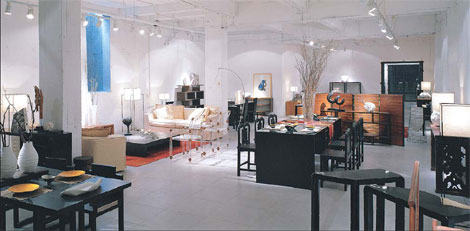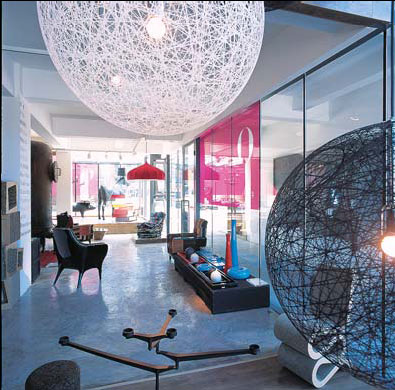Culture
Where antique culture touches modern design
By Renee Weisskopf (China Daily)
Updated: 2010-08-02 14:13
 |
Large Medium Small |
 |
|
A wide variety of stylish goods fill the basement showroom at O Gallery. [Photos provided to China Daily] |
Beijing is home to countless shops that sell furniture and home decorations, but very few are born from the desire to promote innovative Chinese designers and furniture items that simultaneously embrace traditional Chinese culture and our modern times.
Nestled in the trendy, yet serene 751 D-Park just an arm's length from the bustling 798 art zone is O Gallery - a young business that does precisely that. Despite its short name, the essence of O Gallery is difficult to define in just a few words. It's not just a gallery, nor is it simply a furniture shop. If anything, O Gallery is the physical incarceration of a specific concept and movement in Chinese society, as Tang Meng, one of the gallery's founders, explained.
Before 1995, the concept of having a trendy home was still largely undeveloped in China. Most people could either only afford the most basic items of functional furniture, or simply lacked the awareness of investing in an aesthetically pleasing interior.
 |
|
The first floor is home to a range of interior accessories. [Photos provided to China Daily] |

This void didn't go unnoticed by the then young Chinese art graduate Song Tao. Having freshly graduated with a master's degree from 1 Pantheon Sorbonne in Paris in 1993, Song returned to China and began heavily engaging himself in the promotion of Chinese contemporary art and design, especially interior and product design.
After founding Tao Gallery and later Tao Studio, Tang founded his own furnishing brand called Zi Zao She in 2002. Unlike most Chinese furniture brands that merely wanted to imitate Western trends, Tao carved a niche for himself by reviving traditional Chinese culture in modern furniture design. Several high-profile exhibitions and the establishment of the China Furniture Design Brand Alliance (CFDBA) later, O Gallery was born.
Overlooking a giant mound of coal on one side and the eye-catching rusty tanks and industrial structures left behind from the 751 power factory on the other, O Gallery consists of three floors: the first floor is home to smaller unique accessories like glasses, clocks, shelves, mirrors, chairs, coffee tables and lighting by an international and domestic team of top designer brands including Moooi, Neru & Hu, Alessi and Kartell.
The second floor is where the gallery's office is located and where a creative, young team of Chinese designers operates O Gallery's burgeoning interior design business, O Studio. However, the heart of O Gallery's being lies in the basement, for it is here in a huge, underground space where the gems of China's top contemporary furniture designers are found.
The basement contains a number of Song's signature pieces, which clearly fuse traditional Chinese elements with contemporary furniture aesthetics and are mostly made of metal and ancient solid wood.
Other highlights include beautiful wooden tables dating back to the Qing Dynasty by designer Chun Zai. Three separate rooms filled with stunning, one-of-a-kind tables, chairs, couches, wooden partitions and more transform this basement into a Mecca for anyone with an appreciation for art and top-quality innovative interior design.
Besides the existing furniture collection on display, O Gallery also designs unique pieces on commission and offers interior design services, ranging from interior planning to full-out housing arrangement. This side of the business is run by O Studio, the design and production branch that was founded at the same time as the gallery in 2009.
As Tang Meng explained, the name "O" is a circle that symbolizes integration and new possibilities; O Gallery combines contemporary art, furniture and interior design with traditional Chinese culture and places it firmly within a modern context. It also allows top international brands and upcoming Chinese designers to display their works side by side.
In short, O Gallery is a shop for furniture and home dcor buyers, a source of inspiration for interior design conscious people and a platform of exchange and understanding between contemporary designers from all over the world.
China Daily